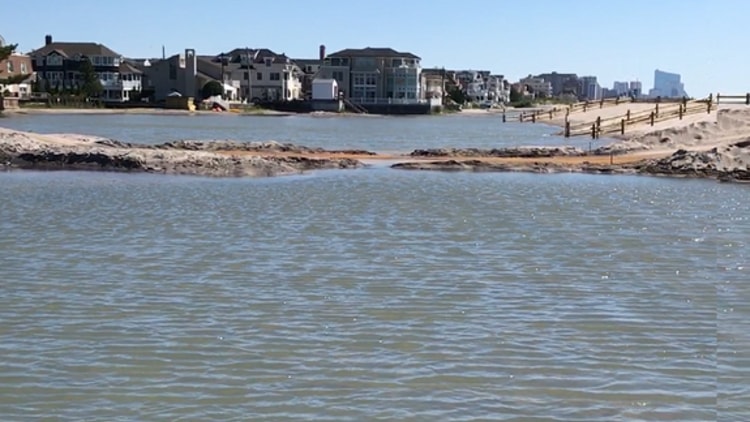Article originally published in the American City Business Journals on Aug 22, 2017
Best practices of leading business organizations include becoming the preferred provider of products or services to their markets. They do this in part by listening to their customers and providing a great experience so that customers choose to do business with them rather than their competition.
Governmental agencies have no such competition, but shouldn’t these agencies still do the same – listen to and provide a great experience to taxpayers?
A coastal protection project by the New Jersey Department of Environmental Protection designed and managed by the U.S. Army Corps of Engineers offers a glimpse at how governmental organizations can drop the ball when it comes to best serving their taxpayers — in this case, the residents of Margate, New Jersey.
The project involves protection of the city against flooding during severe storms. The NJDEP and USACE chose to provide this protection by constructing sand dunes – a 12.5-foot elevated strip of sand about 100 feet wide, along the beaches of Margate.
Dune construction is part of the Absecon Island Storm Damage Reduction project. This project, funded by the federal government, was launched because of the heavy damage suffered by many New Jersey coastal towns from Superstorm Sandy nearly five years ago.
After the storm, New Jersey Gov. Chris Christie mandated that the entire coastline of New Jersey be protected by dunes — despite a “one-size-fits-all” solution perhaps not being appropriate for every New Jersey coastal town, or that perhaps a solution of say, 90 percent as effective like sea walls, would be the preferred alternative.
The citizens of Margate did not want the dunes for a variety of reasons, including anticipated issues with street storm drainage. Many residents favored spending the funds on beefing up the sea walls that have protected Margate for decades and, in the long run, would have avoided the expense of dune re-nourishment every few years or after major storms.
In two referendums, the citizens of Margate voted against the dunes and authorized the Margate commissioners to go to court to oppose the project. Dunes, however, were the paradigm of NJDEP and USACE. Margate lost its court case in March 2016 in New Jersey Superior Court, allowing dune construction to proceed.
The result is that this dune construction project is currently underway at a time when thousands of vacationers visit during July and August to enjoy Margate’s pristine beaches. This disruption includes closing stretches of the beaches during construction, restricting access to sections of the ocean due to higher than acceptable bacteria count, and installing a 30-inch pipe running down the beach to transport sand slurry to construct the dunes from sand dredged offshore.
The disruption to beach access would be bad enough if the project went as planned. Unfortunately, it did not. A design based on faulty assumptions of street drainage issues caused flooding of 100- to 150-foot-wide drainage basins constructed between the sea walls at the end of Margate’s streets and the base of the dunes. Many of these streets had no drainage issues and did not require drainage basins.
To create the drainage basins, the USACE removed the top layers of sand from the beach that absorbed rainwater. The thought was that rainwater would percolate into the newly exposed sand, now much closer to the water table. However, percolation was not effective during a severe rainstorm on July 29 and a subsequent rainstorm a week later.
The storms created huge ponds of stagnant, contaminated water in the basins that ran for blocks, preventing access to the beach and creating a health and safety hazard. This further disrupted the use of Margate’s beaches during the height of the summer season.
On Aug. 3, Margate took the NJDEP to New Jersey Superior Court and asked Judge Julio Mendez to stop construction of the dunes. After viewing photos of the flooded drainage basins and calling the situation “horrendous,” he ruled that Margate residents were suffering “irreparable harm.” Mendez issued an eight-day temporary restraining order and ordered the NJDEP, USACE and Margate to work on a solution to the ponding issue.
Concerned about the mounting standby costs of the halted project, USACE on Aug. 9 petitioned federal court Judge Renee Bumb to overturn Mendez’s restraining order so the project could continue, which she did. Bumb also ordered the basins to be pumped out whenever the basins had two or more inches of water.
The USACE is now filling in the drainage basins with sand, hopefully creating sufficient ability for rain water percolation above the water table to be effective.
On the handful of Margate streets that end below the level of the beach before dune construction, USACE removed sand so that the beach is now just below the drainage scuppers in the sea walls. This allowed these streets to drain, mimicking what occurred before the dunes were constructed, when the city of Margate periodically trenched the beach to allow drainage of these streets.
Whether these drainage areas on beach will require pumping pools of rainwater, or pipes from the sea wall scuppers under the dunes and onto the ocean side of the beach, is yet to be determined.
But from the broader perspective, the question comes back to this: Can governmental agencies work to provide a great taxpayer experience, like businesses work to provide a great customer experience? Yes, they can, and hopefully they will, effectively listening to and considering the views of their “customers” – the taxpayers that they serve.
Stan Silverman is founder and CEO of Silverman Leadership. He is a speaker, advisor and nationally syndicated writer on leadership, entrepreneurship and corporate governance. Silverman earned a Bachelor of Science degree in chemical engineering and an MBA degree from Drexel University. He is also an alumnus of the Advanced Management Program at the Harvard Business School. He can be reached at Stan@SilvermanLeadership.com.

